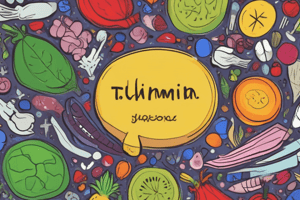Podcast
Questions and Answers
What is the biologically active form of thiamin?
What is the biologically active form of thiamin?
- Thiamin phosphate
- Thiamin triphosphate
- Thiamin pyrophosphate (correct)
- Thiamin diphosphate
Which of the following is NOT a source of thiamin?
Which of the following is NOT a source of thiamin?
- Moderate amounts in nutritious food
- Whole-grain products
- Fortified grain products
- Fruits (correct)
What is a symptom of thiamin deficiency leading to wet beriberi?
What is a symptom of thiamin deficiency leading to wet beriberi?
- Nerve cell damage
- Blood vessel dilation (correct)
- Cognitive impairment
- Muscle weakness
What is the recommended daily allowance of thiamin for men?
What is the recommended daily allowance of thiamin for men?
Which of the following best describes thiamin's role in the body?
Which of the following best describes thiamin's role in the body?
Prolonged thiamin deficiency can lead to which condition?
Prolonged thiamin deficiency can lead to which condition?
Thiamin is particularly important for which type of cells in the body?
Thiamin is particularly important for which type of cells in the body?
What are the two biologically active forms of Riboflavin (Vitamin B2)?
What are the two biologically active forms of Riboflavin (Vitamin B2)?
Which of the following is a primary role of Niacin (Vitamin B3) in the body?
Which of the following is a primary role of Niacin (Vitamin B3) in the body?
What causes inflammation of the membranes of the mouth and GI tract?
What causes inflammation of the membranes of the mouth and GI tract?
Which food group is the primary source of riboflavin in many diets?
Which food group is the primary source of riboflavin in many diets?
How much riboflavin is recommended for men and women daily?
How much riboflavin is recommended for men and women daily?
What is the central component of the biologically active forms of Niacin?
What is the central component of the biologically active forms of Niacin?
What deficiency can lead to neurological degeneration due to low NAD levels?
What deficiency can lead to neurological degeneration due to low NAD levels?
Approximately how much tryptophan is needed to produce 1 mg of niacin?
Approximately how much tryptophan is needed to produce 1 mg of niacin?
What symptoms are associated with riboflavin toxicity?
What symptoms are associated with riboflavin toxicity?
What is the recommended daily allowance (RDA) of folate for adults?
What is the recommended daily allowance (RDA) of folate for adults?
Which of the following is a primary function of vitamin B12 in the body?
Which of the following is a primary function of vitamin B12 in the body?
What condition is caused by a deficiency of vitamin B12?
What condition is caused by a deficiency of vitamin B12?
Why is vitamin B12 unique among vitamins?
Why is vitamin B12 unique among vitamins?
What is the primary role of choline in the body?
What is the primary role of choline in the body?
What is a significant role of pantothenic acid in the body?
What is a significant role of pantothenic acid in the body?
Which food sources are particularly rich in pantothenic acid?
Which food sources are particularly rich in pantothenic acid?
What is the adult adequate intake recommendation for pantothenic acid?
What is the adult adequate intake recommendation for pantothenic acid?
How many forms does Vitamin B6 occur in?
How many forms does Vitamin B6 occur in?
What role does PLP (pyridoxal phosphate) play in the body?
What role does PLP (pyridoxal phosphate) play in the body?
What is one function of PLP related to tryptophan?
What is one function of PLP related to tryptophan?
What nutrient synthesis does PLP not participate in?
What nutrient synthesis does PLP not participate in?
What are the reported symptoms of pantothenic acid deficiency?
What are the reported symptoms of pantothenic acid deficiency?
What is a notable characteristic of pantothenic acid toxicity?
What is a notable characteristic of pantothenic acid toxicity?
Which of the following metabolic processes is not associated with Vitamin B6?
Which of the following metabolic processes is not associated with Vitamin B6?
What is one of the primary functions of folate in the body?
What is one of the primary functions of folate in the body?
Which food sources are rich in Vitamin B6?
Which food sources are rich in Vitamin B6?
What daily recommended amount of Vitamin B6 is suggested for adults?
What daily recommended amount of Vitamin B6 is suggested for adults?
What symptom is associated with a deficiency in Vitamin B6?
What symptom is associated with a deficiency in Vitamin B6?
What is a potential consequence of folate deficiency during pregnancy?
What is a potential consequence of folate deficiency during pregnancy?
What is the upper limit (UL) of Vitamin B6 intake for adults to avoid toxicity?
What is the upper limit (UL) of Vitamin B6 intake for adults to avoid toxicity?
What symptom can result from excessive intake of folate?
What symptom can result from excessive intake of folate?
Which of the following is a role of tetrahydrofolate (THF) in the body?
Which of the following is a role of tetrahydrofolate (THF) in the body?
What type of anemia can result from folate deficiency?
What type of anemia can result from folate deficiency?
How does folate contribute to the conversion of vitamin B12?
How does folate contribute to the conversion of vitamin B12?
Flashcards
B vitamins
B vitamins
A group of essential nutrients that play crucial roles in energy metabolism, cell growth, and other bodily functions.
Thiamin (Vitamin B1)
Thiamin (Vitamin B1)
A B vitamin essential for carbohydrate metabolism, nerve function, and muscle activity.
Thiamin Pyrophosphate (TPP)
Thiamin Pyrophosphate (TPP)
The active form of thiamin, which acts as a coenzyme in carbohydrate metabolism.
What is the role of thiamin in energy metabolism?
What is the role of thiamin in energy metabolism?
Signup and view all the flashcards
What are the common sources of thiamin?
What are the common sources of thiamin?
Signup and view all the flashcards
What is Beriberi?
What is Beriberi?
Signup and view all the flashcards
What are the types of Beriberi?
What are the types of Beriberi?
Signup and view all the flashcards
Riboflavin (Vitamin B2) forms
Riboflavin (Vitamin B2) forms
Signup and view all the flashcards
Riboflavin's role in the body
Riboflavin's role in the body
Signup and view all the flashcards
Riboflavin deficiency symptoms
Riboflavin deficiency symptoms
Signup and view all the flashcards
Riboflavin toxicity
Riboflavin toxicity
Signup and view all the flashcards
Foods rich in Riboflavin
Foods rich in Riboflavin
Signup and view all the flashcards
Niacin (Vitamin B3) forms
Niacin (Vitamin B3) forms
Signup and view all the flashcards
Niacin's role in the body
Niacin's role in the body
Signup and view all the flashcards
Niacin in foods
Niacin in foods
Signup and view all the flashcards
How is Niacin intake measured?
How is Niacin intake measured?
Signup and view all the flashcards
Pantothenic Acid
Pantothenic Acid
Signup and view all the flashcards
Acetyl-CoA's Role
Acetyl-CoA's Role
Signup and view all the flashcards
Pantothenic Acid Deficiency
Pantothenic Acid Deficiency
Signup and view all the flashcards
Vitamin B6 Forms
Vitamin B6 Forms
Signup and view all the flashcards
PLP (Pyridoxal Phosphate)
PLP (Pyridoxal Phosphate)
Signup and view all the flashcards
Tryptophan's Conversion
Tryptophan's Conversion
Signup and view all the flashcards
Vitamin B6 Metabolism
Vitamin B6 Metabolism
Signup and view all the flashcards
PLP's Role in Red Blood Cells
PLP's Role in Red Blood Cells
Signup and view all the flashcards
Vitamin B6 in Nucleic Acid Synthesis
Vitamin B6 in Nucleic Acid Synthesis
Signup and view all the flashcards
Vitamin B6's Role in Lecithin Synthesis
Vitamin B6's Role in Lecithin Synthesis
Signup and view all the flashcards
Folate RDA
Folate RDA
Signup and view all the flashcards
Folate UL
Folate UL
Signup and view all the flashcards
What is Pernicious Anemia?
What is Pernicious Anemia?
Signup and view all the flashcards
Vitamin B12 in foods
Vitamin B12 in foods
Signup and view all the flashcards
Choline Role
Choline Role
Signup and view all the flashcards
Vitamin B6 Role
Vitamin B6 Role
Signup and view all the flashcards
Vitamin B6 Deficiency
Vitamin B6 Deficiency
Signup and view all the flashcards
Vitamin B6 Toxicity
Vitamin B6 Toxicity
Signup and view all the flashcards
Vitamin B6 RDA
Vitamin B6 RDA
Signup and view all the flashcards
Vitamin B6 UL
Vitamin B6 UL
Signup and view all the flashcards
Folate and Neural Tube Defects
Folate and Neural Tube Defects
Signup and view all the flashcards
Folate Deficiency Symptoms
Folate Deficiency Symptoms
Signup and view all the flashcards
Folate Toxicity
Folate Toxicity
Signup and view all the flashcards
Folate Sources
Folate Sources
Signup and view all the flashcards
Study Notes
Water-Soluble Vitamins: B Vitamins and Vitamin C
- Water-soluble vitamins are organic, essential nutrients needed in small amounts for optimal health.
- Examples include B vitamins and vitamin C.
- The first vitamins discovered contained nitrogen.
Chapter Outline
- An overview of vitamins, roles, deficiency symptoms, and food sources will be covered for each of the B vitamins and vitamin C.
Vitamins - An Overview
- Vitamins are organic nutrients.
- Vitamins are needed in small amounts to prevent deficiencies and support optimal health.
- They differ from carbohydrates, fats, and proteins because they are not linked in chains and do not produce energy directly when metabolized.
- Daily intake is measured in micrograms or milligrams, not grams.
- Vitamins are essential, organic, and available from food.
How Vitamins Differ from Other Macronutrients
- Vitamins are individual units, not linked like molecules of glucose or amino acids.
- Many vitamins assist enzymes involved in releasing energy.
Classification of Vitamins
- Vitamins are categorized as either water-soluble or fat-soluble.
- Water-soluble vitamins include the B vitamins and vitamin C, and these are absorbed directly into the bloodstream.
- Fat-soluble vitamins include vitamins A,D,E, and K; they require protein carriers to pass into the lymph and then into the bloodstream. These are stored in fat-tissue.
Water-Soluble Vitamins - Handling and Requirements
- Absorption: Travel directly into the bloodstream.
- Transportation: Travel freely in water-filled portions of the body.
- Storage: Circulates freely throughout the body. Excess is excreted by the kidneys in urine.
- Toxicity: Can reach toxic levels if consumed in large quantities from supplements.
- Requirements: Needed frequently (e.g., 1-3 days).
The B Vitamins
- Choline, thiamine, riboflavin, niacin, biotin, pantothenic acid and vitamin B6.
- Vitamin B12 and folate are also considered B vitamins.
- The B vitamins have different functions within the body, all relating to energy metabolism. Specific functions are detailed in the slides discussing each individual vitamin.
Several B Vitamins
- Thiamine, riboflavin, niacin, pantothenic acid, and biotin are part of the coenzymes which assist enzymes for energy release from carbohydrates, fats, and protein.
The B Vitamin Reactions for Energy Release
- Coenzymes accept and transfer electrons and groups of atoms.
- Compounds are attracted to their sites on enzymes during the reactions that enable the release of energy.
Simplified Overview of Energy-Yielding Pathways
- All energy-producing nutrients (protein, carbohydrates, and fat) are broken down to Acetyl CoA.
- Acetyl CoA enters the TCA cycle, and hydrogen atoms with electrons are released to carry to the transport chain which enables synthesis of ATP.
- Hydrogen atoms react with oxygen to produce water.
Chemical Intermediates in Metabolic Pathways
- Che mical intermediates help with interlinking between different metabolic pathways for energy production and specific vitamin use in many reactions.
Thiamin (Vitamin B1)
- Active form is Thiamin pyrophosphate (TPP).
- TPP is involved in energy metabolism and occupies a specific site on nerve cell membranes.
- TPP helps to produce energy by converting pyruvate to Acetyl CoA.
Thiamine's Food Sources and Recommendations
- Found in whole-grain, fortified, or enriched grain products in moderate amounts in nutritious foods.
- Recommended daily intake for men is 1.2 mg/day, while for women it is 1.1 mg/day.
Thiamin Deficiency
- People relying on empty-calorie foods or beverages risk thiamin deficiency.
- Prolonged deficiency leads to beriberi, a disease exhibiting dry or wet symptoms.
Riboflavin (Vitamin B2)
- Active forms: flavin mononucleotide (FMN) and flavin adenine dinucleotide (FAD).
- Involved in energy-releasing reactions.
- Function as coenzymes.
Riboflavin Roles In The Body
- It plays many roles in metabolic reactions, most notably in energy metabolism.
Niacin (Nicotinic Acid; Vitamin B3)
- Active forms: nicotinamide adenine dinucleotide (NAD+) and nicotinamide adenine dinucleotide phosphate (NADP+).
- Important in energy-transfer reactions.
- Converts glucose and fat into energy.
- Protects against some neurodegenerative illnesses.
Niacin Food Sources and Recommendations
- Found in milk, eggs, meat, poultry, fish: whole grains, fortified and enriched-grain products; nuts.
- Converts amino acid tryptophan to niacin.
- Recommended intakes are expressed as Niacin Equivalents (NE), including the amount of niacin present in food. (Tryptophan intake is often considered as well to assess the amount of NE obtained).
Niacin Deficiency and Toxicity
- Deficiency can lead to pellagra.
- High doses from supplements can result in "niacin flush".
Biotin
- Acts as a coenzyme, carrying activated carbon dioxide in metabolic processes.
- Involved in gluconeogenesis, fatty acid synthesis, and certain fatty acid and amino acid breakdowns.
Biotin in Food Sources and Recommendations
- Biotin is widespread in foods including egg yolks, liver, fish, and whole grains.
- Recommended daily intake for adults is 30 µg/day.
Pantothenic Acid (Vitamin B5)
- Part of coenzyme A (CoA) which forms acetyl-CoA, a key compound in various metabolic pathways (including the TCA cycle).
- Involved in lipid, neurotransmitter, and hemoglobin synthesis.
Pantothenic Acid Food Sources, Recommendations, and Deficiency Symptoms
- Found in beef, poultry, whole grains, potatoes, tomatoes, and broccoli.
- Recommended intake for adults is 5 mg/day.
- Deficiency symptoms are rare.
Vitamin B6
- Occurs in three forms: pyridoxal, pyridoxine, and pyridoxamine.
- All can be converted to the coenzyme PLP or pyridoxal phosphate.
- PLP is involved in over 100 reactions, including carbohydrate and amino acid metabolism.
- Converts tryptophan to niacin and to the neurotransmitter serotonin.
- Plays a role in the synthesis of heme, nucleic acids, and lecithin.
Vitamin B6 Recommendations and Food Sources
- Found in meats, fish, poultry, potatoes, legumes, fortified cereals, and liver.
- Recommended daily intake for adults is 1.3 mg.
- Large doses can cause neurological damage.
Folate (Folacin / Folic Acid)
- Converted to tetrahydrofolate (THF).
- THF receives one-carbon fragments and transfers in amino acid synthesis and other important metabolic reactions.
- Activated folate coenzyme is involved in synthesis of DNA, RNA.
Folate in foods and recommendations
- Folate is widespread in fortified grains, leafy green vegetables, legumes, seeds, and liver.
- Daily recommendation of 400 µg.
- A high upper limit (UL) intake is 1000 ug.
Folate and Neural Tube Defects
- Folate requirements are especially crucial during pregnancy.
- Folate supplements can prevent neural tube defects in developing fetuses, reducing associated disorders and death.
Vitamin B12 (Cobalamin)
- Physiologic coenzyme forms: 5'-deoxyadenosylcobalamin and methylcobalamin.
- Vitamin B12 conversion to coenzyme form needs activation. Vitamin B12 depends on the conversion of folate and vice versa.
- Needed for DNA synthesis and amino acid metabolism.
- Involved in converting homocysteine to methionine and thus maintaining amino acid homoeostasis.
Vitamin B12 Digestion and Absorption
- Digestion involves several steps to absorb vitamin B12.
- Diet -> Stomach (parietal cells and R-protein that carries B12) -> Intestine -> Absorption into mucosal cells -> Blood.
Vitamin B12 and Folate Interactions
- Both vitamin B12 and folate depend on each other for activation (especially regarding folate conversion).
Vitamin B12 in the body
- The regeneration of the amino acid methionine and synthesis of both DNA and RNA depends on both folate and vitamin B12.
- Vitamin B12 maintains the sheath surrounding nerve fibers, promoting their normal growth and activity.
- Bone cell activity and metabolism depend on vitamin B12.
Vitamin B12 Food Sources and Recommendations
- Primarily derived from animals. (Meats, fish, poultry, dairy products)
- Adults require 2.4 µg daily.
Choline
- Although not a vitamin, it's grouped with the B vitamins.
- Essential nutrient involved in the synthesis of the neurotransmitter acetylcholine and the phospholipid lecithin.
Choline Food Sources, Recommendations, and Comments
- Sources include milk, liver, eggs, and peanuts
- AI: Men 550 mg/d and women 425 mg/d. UL:Adults 3500 mg/d.
- Liver damage can result from a deficiency. Low blood pressure and reduced growth rate may result from a high intake.
Vitamin C (Ascorbic Acid)
- Main function is as a reducing agent in multiple metabolic reactions.
- It protects against oxidative damage.
- Facilitates collagen formation, important for tissue structure and wound healing.
- Strengthens the body's resistance to infection.
- Aids in iron absorption.
Vitamin C Food Sources and Recommendations
- Citrus fruits, dark green vegetables, strawberries, tomatoes, and mangoes.
- Adults require 90 mg/d for men and 75 mg/d for women. Smokers need 35 mg more than non-smokers.
- UL: 2000 mg/d for adults.
Studying That Suits You
Use AI to generate personalized quizzes and flashcards to suit your learning preferences.




